5 Shifts Needed to Decarbonize Industry
by Anna Nilsson (Climate Action Tracker) and Neelam Singh (World Resources Institute) under the Systems Change Lab project
Despite challenges, achieving net-zero emissions from industry is possible
If the world is going to shift away from the most damaging impacts of the climate crisis, it needs to decarbonize the industry sector. Industry is made up of the processes we use to extract and refine raw materials, and turn them into the roads, buildings, appliances, equipment, vehicles and products all around us.
These industrial activities — including mining, manufacturing, construction and waste processing — accounted for one-fifth of direct global emissions in 2019. When you include indirect emissions from power and heat, that percentage goes up to almost 30% of global emissions. In addition, the industry sector also encompasses the production of oil and gas (which separately accounts for over 4% of global emissions and is included under the energy sector).
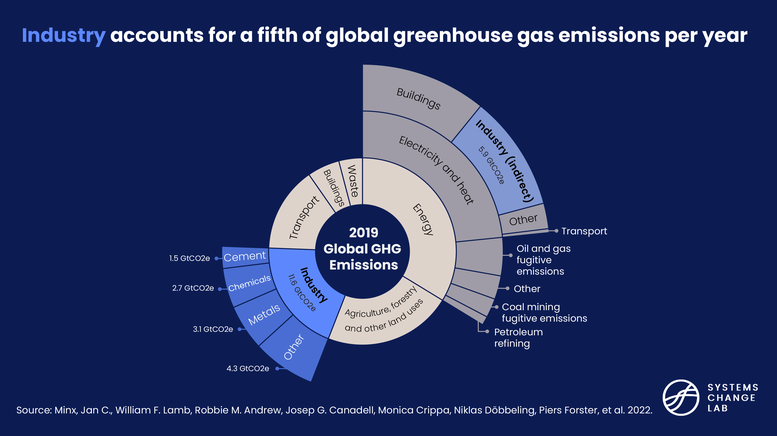
A large part of the sector’s emissions originates from some of the most carbon intensive sectors of the economy, such as cement, steel and chemicals. Not only industry burn large amounts of fossil fuels, but the manufacturing of some industrial materials requires high temperature heat and involves processes which generate emissions that are not related to burning fossil fuels. That means industry cannot be decarbonized simply by switching to clean energy but will also require the application of new technologies and methods.
Overhauling industry to build a zero-emissions, equitable world while not harming nature can’t happen fast enough. Since 2000, industry’s emissions have risen faster than any of the 6 emitting systems —such as transportation, buildings and power — tracked by Systems Change Lab’s State of Climate Action. And the demand for many industrial materials is projected to increase as more countries industrialize.
Despite these challenges, achieving net-zero emissions from industry is possible. It will require reducing emissions from manufacturing processes as well as lowering demand for conventionally produced materials and replacing it with low-carbon products. Systems Change Lab identifies five shifts that are critical to transforming industry to avoid some of the worst impacts of climate change.
1. Reduce Demand for Steel and Cement
We rely on industrial products for every facet of our lives, from the materials used to build our homes to life-saving medical equipment to how we move from place to place. These products will also be essential as we expand public transit systems, retrofit more energy-efficient buildings and build other infrastructure necessary for the low-carbon transition.
Cement and steel together account for about 15% of global carbon-dioxide (CO2) emissions, so reducing the rate of demand for these products is key to lowering industrial emissions.
One way to accomplish this is through measures such as material substitution while ensuring that the substitute material does not bring other harmful side effects, reuse and recycling programs, shared use of products (such as via shared mobility systems), and improved designs that use less material (such as lightweight design for cars so as to use less steel) and prolong a product’s lifetime. Employing these kinds of strategies can reduce steel demand by up to 40% by 2050.
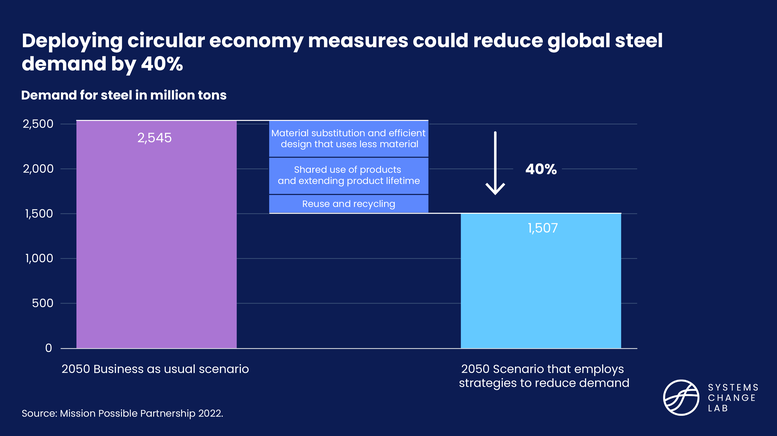
Similarly, efficiency in design and construction can reduce demand for materials, and construction methods can be updated to require less cement and steel while remaining within safety limits.
Urban planning that emphasizes compact cities and other infrastructure improvements (such as recycling, waste collection and sorting centers, and shared building space) can also help lower demand for carbon-intensive industrial materials.
Achieving the full potential of this shift will require actions across the entire industry, particularly those involved in converting steel and cement into final products. Examples include architects, designers and engineers, construction companies and the automotive industry. Regulatory policies, such as stricter building codes, can also effectively reduce consumption of building materials while information campaigns and education can play an important role in supporting behavioral change.
2. Improve Industrial Energy Efficiency
Updating existing technology with more efficient technology can reduce emissions and expenditure towards industrial energy. There’s already progress on this front: Industrial energy intensity declined 12% between 2000 and 2020. However, the intensity needs to reduce at an accelerated pace and decline by 26% over the current decade (2020-2030) to reach net zero, according to the International Energy Agency’s net-zero pathway. Further, annual investment in industrial efficiency increased by 7% in 2022 over 2021, but to reach the 2030 investment level, as set by the International Energy Agency, the investment needs to increase by 17.5% annually.
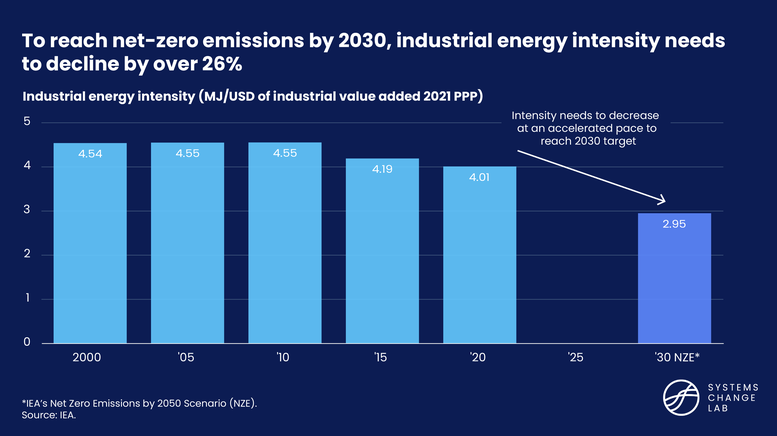
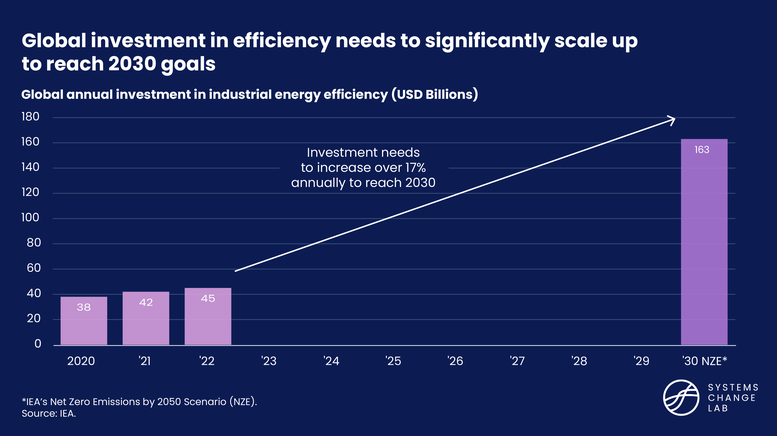
Updating and retrofitting industrial plants with the best available technology can reduce 10% to 20% of industrial emissions and deliver bottom-line benefits by reducing fuel expenditures. Energy efficiency gains and emissions reductions from retrofits in the near term should be balanced with adoption of new decarbonization technologies in the longer term — particularly in the case of industrial plants with long expected lifetimes, such as steel plants.
Further energy efficiency improvements in industry can be encouraged through measures such as energy performance standards mirroring available best practices, mandating energy audits and providing information and training to industries. Reducing fossil fuel subsidies and other economic support for the use of fossil fuels can also indirectly incentivize measures to improve energy efficiency.
3. Electrify Industry
About 51% of energy that is consumed worldwide to produce heat is used in the manufacturing of industrial materials. While the electrification of low- and medium-heat is commercially available today, most efforts to electrify the industry sector have historically targeted non-heating operations, including machinery such as pumps, robotic arms and conveyor belts. As a result, many industrial processes still rely on fossil fuels for heat generation.
About half of the fuel that industrial companies use for energy today could be electrified and decarbonized with commercial technologies coupled with a zero carbon power supply. Yet only 28% of industrial energy was electrified in 2020, meaning that there is significant potential to step up mitigation through available technologies.
The bigger challenge will be to electrify high-temperature heat processes, such as those used for cement production. About 32% of industrial emissions are from generating heat above 1,000 degrees Celsius (1,832 degrees Fahrenheit). These technologies need further investment and research to expedite their deployment and keep the lifetime of fossil fuel-based infrastructure from being extended. As an example, a new clean technology — industrial thermal batteries–can cut emissions at costs competitive with that of natural gas in the U.S. Providing financial incentives for these batteries (for example, explicitly considering thermal batteries under energy storage technology which makes them eligible for tax credits) through existing decarbonization programs can catalyze their wider deployment within the industry.
Achieving higher electrification rates in industry requires measures such as carbon pricing and/or removing fossil fuel subsidies to address the cost competitiveness of renewables-based electricity compared to fossil fuels used in conventional equipment. Further research to improve the efficiency of electric technologies can also reduce the operating costs. The U.S. Department of Energy (DOE), for instance, has announced a new Industrial Heat Shot initiative to develop cost competitive decarbonization technologies for industrial heat. DOE has also allocated up to $70 million in funding towards research and development projects to electrify process heating. Other supporting policies, such as electrification targets and information campaigns, can also incentivize electrification.
4. Commercialize New Solutions for Cement and Steel
Although many heat-dependent industrial processes could be decarbonized through electrification, this is not the case for process emissions. These emissions are the result of chemical reactions that occur during the transformation of raw materials to useful products (for example, iron ore to iron or limestone to clinker), and therefore are difficult or not possible to electrify.
In some cases, zero-carbon energy sources for industrial processes (such as green hydrogen) can be used to avoid the generation of carbon dioxide; for other processes, other materials, like alternative binders in cement production, can be used. But those solutions are unlikely to be sufficient to mitigate all process emissions. In such situations, carbon capture, utilization and storage (CCUS) is likely to become a necessary part of full decarbonization. Most of those technologies need to be further developed, proven at scale and will require significant investment. For example, by one estimate from Wood Mackenzie , decarbonizing the steel industry needs $1.4 trillion in cumulative investment by 2050 across its value chain.
Innovation and technology development will therefore play a major role in this shift. The number of announced low-carbon innovation projects in heavy industries such as cement and steel are increasing. In the cement industry, given the potential role of CCUS technology in decarbonization, it is particularly interesting to track announced CCUS projects. In the steel industry, various alternatives are already available, such as green hydrogen-based steelmaking.
The number of announced cement CCUS projects and low-carbon steel projects is increasing steadily. According to the Mission Possible Partnership, at least 20 commercial-scale CCUS plants need to be in operation by 2030. At least eight new CCSU plants (pilot, demonstration and commercial scale) were announced last year. Out of the total announced plants up until mid-July 2023, 19 are full-scale, according to the Green Cement Technology Tracker. Similarly, the number of announced low-carbon steel projects (pilot, demonstration and commercial scale) have increased rapidly, albeit at a slower rate in the past year. Mission Possible Partnership estimates that 70 near zero emissions steel plants need to be in operation by 2030.
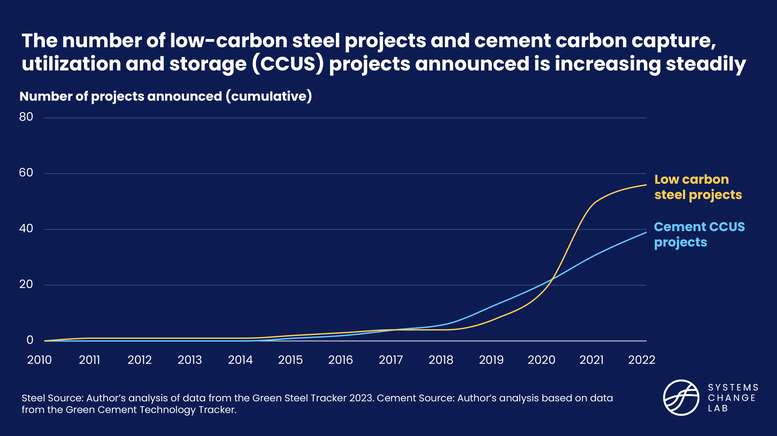
Commercializing these technologies in a timely manner to avoid lock-in and expansion of traditional technologies and putting the sector on a path to net-zero emissions by 2050 will require policymaking that incentivizes increased piloting and demonstration, as well as engagement from the private sector. Policies putting a price on carbon, such as emission trading schemes or carbon taxes, could make zero-carbon technologies more attractive competitive in the long term. Public procurement is also needed to ensure demand for low-carbon industrial products and reduce financial risks for companies.
National net-zero and interim emission reduction targets can send clear signals to the industry and thus incentivize companies to develop their own net-zero strategies. Companies can also engage with other companies, academia and industry associations to exchange on technology development and lessons learned.
Access to finance will be an important piece of the puzzle as the upfront cost of these new technologies are typically significantly higher compared to that of the traditional ones. Demand-stimulating policies such as “carbon contracts for difference,” where companies are compensated by the state for the additional cost of clean technologies can help reduce the financial risk.
Because much of the additional demand for industrial materials is expected to come from developing and emerging economies, and novel low-carbon technologies are largely developed in industrialized economies, technology transfer and international cooperation will be an essential part of global decarbonization.
Low-carbon technologies for the manufacturing of industrial materials also needs to be coupled with increased efforts to expand green hydrogen production. Strategies such as government mandates to require the use of green ammonia (which is produced from green hydrogen) in fertilizers can kick start green hydrogen production and help scale its use in other industries too. Since the cost of green hydrogen is highly influenced by the cost of renewable electricity generation and the transportation of hydrogen, some industrial plants may face relocation closer to low-cost, zero-carbon energy in order to stay cost-competitive with traditional production routes.
5. Reduce Methane Emissions from Oil and Gas Operations as They Are Phased Down
While oil and gas production are generally accounted for in the energy sector, there are industrial activities related to oil and gas which are a significant source of methane emissions. The IEA estimated in 2021 that limiting warming to 1.5 degrees C (2.7 degrees F) would require halting new oil and gas exploration and significantly decreasing production and consumption through 2050, starting this decade.
Rapidly reducing oil and gas production is crucial for lowering CO2 emissions. But minimizing methane emissions from oil and gas production as it is phased down is also essential, as methane is 84 to 87 times more potent than C02 in the short term and therefore reducing methane will have an outsized effect on limiting warming in the coming decades. Oil and gas related methane emissions come from a variety of sources, including upstream exploration and production, storage, and pipelines. Certain equipment, including pneumatic controllers and valves, tends to be particularly leaky. Incomplete gas flaring and venting — planned releases of gas during well completions or maintenance — also contribute emissions. According to the IEA, about 40% of oil and gas-related methane emissions could be eliminated at no net cost using existing technologies.
In 2021, methane emissions from oil and gas production totaled 82 million tonnes. To prevent the most harmful impacts of global warming, these emissions must be slashed to 17 million tonnes by 2030 — an almost 80% decrease from 2022 levels — through reductions in oil and gas production and other actions. Key international coalitions are now focused on ending routine flaring and venting by 2030 and identifying and fixing methane leaks, all of which could drastically reduce emissions.
Decarbonizing Industry Through Ambitious Targets and Innovative Solutions
These five shifts are all essential parts of achieving industrial decarbonization. Tracking progress allows us to identify technical and policy gaps essential to achieving decarbonization by 2050. Industrial decarbonization is possible on an accelerated timeline but it will require concerted action from a wide range of stakeholders across the sector to develop innovative technological solutions towards achieving the goals outlined in the international Paris Agreement on climate change.
Links
This blog has been cross-posted on the Systems Change Lab website and on the WRI website.
Explore System Spotlights
This article is a part of a series profiling the major systems tracked by Systems Change Lab, a collaborative initiative — which includes an open-sourced data platform — that is designed to spur action at the pace and scale needed to limit global warming to 1.5 degrees Celsius, halt biodiversity loss and build a just and equitable economy.
Also in this series:
- 5 Shifts to Transform Transportation Systems and Meet Climate Goals
- 4 Shifts Needed to Create a Carbon-free Power System
- 6 Shifts the Finance System Can Make to Build a Sustainable Future
Convened by WRI and the Bezos Earth Fund, Systems Change Lab supports the UN Climate Change High-Level Champions and works with key partners and funders including Climate Action Tracker (a project of New Climate Institute and Climate Analytics), ClimateWorks Foundation, Global Envirentonm Facility, Just Climate, Mission Possible Partnership, Systemiq, University of Exeter and the University of Tokyo’s Center for Global Commons, among others. Systems Change Lab is a component of the Global Commons Alliance.
Stay informed
Subscribe to our newsletter